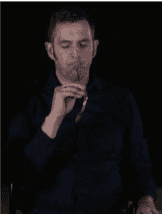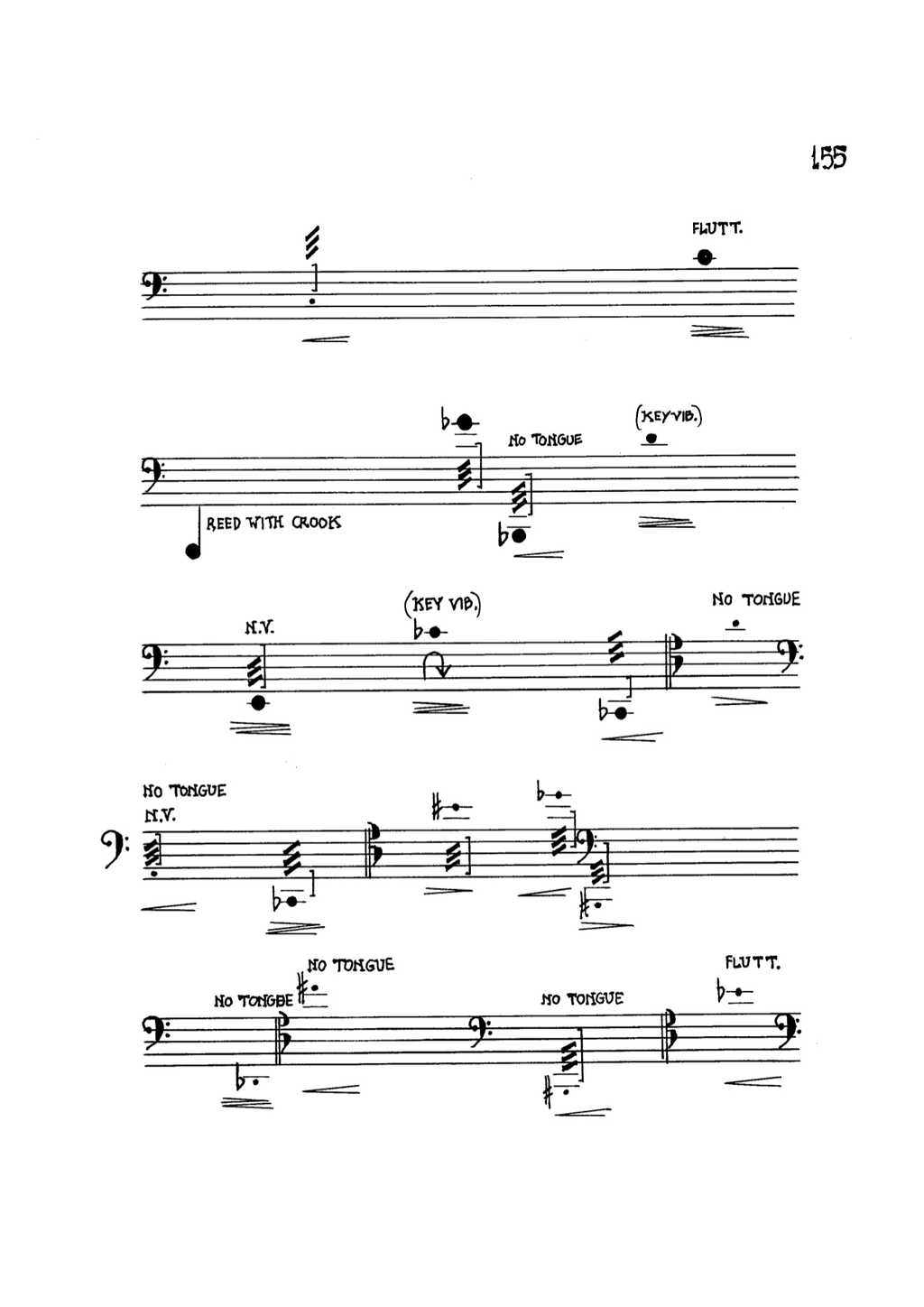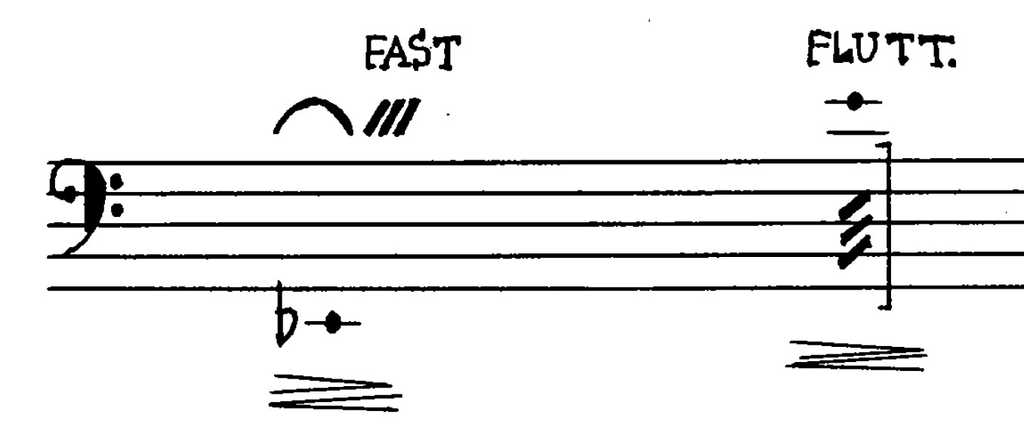Solo for Bassoon and Baryton Saxophone
Christian Forshaw: Performing the Solo for Bassoon and Baryton Saxophone
John Cage, Solo for Bassoon and Baryton Saxophone (page 151)
Christian Forshaw
Introduction
Cage once described the Solo for Bassoon and Baryton [sic] Saxophone as ‘quite uninteresting’ (John Cage to Pierre Marietan, 31 August 1970 (source: John Cage Collection)). It is certainly the sparsest of the woodwind parts, containing the fewest number of sounds overall. Little is known about Sy Schwartzberg, who performed the part in the premiere, other than that he seems to have been primarily a jazz bassoonist. Nevertheless, the part breaks new ground in terms of extended techniques (particularly for bassoon) and contains some distinctive sounds that don’t appear in any of the other Concert parts.
Instruments
The Solo for Bassoon and Baryton Saxophone seems to be the most extreme of the instrumental parts in terms of requiring the player to move between two apparently unrelated instruments (and their associated keys and clefs). It is for this reason, perhaps, that the piece has never been recorded using its original instrumentation, with commercial recordings splitting the part in two: in John Cage – Sylvano Bussotti (1995) Paolo Carlini performs the material solely written for bassoon with the Solo for Piano, and similarly Ulrich Krieger’s ‘Solo for Baritone Saxophone’ recording on The Complete John Cage Edition, Volume 35 (2002) only uses the saxophone material. However, these two instruments were often doubled in earlier wind sections, for example, cabarets such as Threepenny Opera (Kurt Weill, 1928) and Broadway musicals (particularly reed 5 parts), for example, Kiss Me, Kate (Cole Porter, 1948), Gentlemen Prefer Blondes (Jule Styne, 1949) and The Pajama Game (Adler & Ross, 1955). Christian Forshaw discusses some of the practical considerations of moving between instruments in interview.
Pitch
Sliding tones and microtonal slides

Sliding tones are a common indication in the instrumental parts. Cage writes: ‘Curves following notes are sliding tones (gliss.)’ (unlike some of the other parts, the explanatory sentence ‘They do not refer to time-length but only to direction in pitch’ is omitted). As with the notehead sizes, where a large notehead does not necessarily indicate a loud sound, so here a long sliding tone indication does not necessarily indicate a prolonged glissando, and could instead by read as a very short duration, taking in the various curves and indentations as quickly as possible. With only a few exceptions (and then only the saxophone) sliding tones are assigned to the stemmed notes under the stave (usually reserved for noises) and played using the mouthpiece (saxophone) or and crook or reed and crook (bassoon) only.
Approximately a quarter of the pitches require microtonal slides, for which Cage provides the following instructions: ‘Arrows going up or down, or up and down are microtonal slides with lip’. Forshaw demonstrates the technique in interview.
Tremolandi

Tremolo is an effect which is only used in bassoon/saxophone and the clarinet parts (although in the Solo for Clarinet it is treated as a noise element only). According to Cage’s instructions, ‘Tremolandi are between the note written and any other of the player’s choice within the bracket above or below the note’, and it is used frequently throughout the part, even accounting for two-thirds of the pitches on page 155. Forshaw discusses the practicalities of performing the technique in interview.
Dynamics
In addition to the use of different sized noteheads, which are indicative of either dynamics or durations of a sound, or both, the majority of sounds have dynamics assigned to them and the Solo for Bassoon and Baryton Saxophone, in common with the flute and brass parts, is overwhelmingly biased towards crescendos and combinations of dynamics, these latter being a ‘combination of two or more’ crescendos and diminuendos. Although, curiously, the bassoon/saxophone part omits the bracketed word ‘(espressivo)’ found in all the other parts, the player is still free to choose the ‘intensity and duration’ of these, and the overriding character, then, is one of change and improvisation with respect to dynamics throughout the Solo.
Articulation
Cage’s approach to articulation in the bassoon/saxophone part is quite specific. The instructions state: ‘All tones are to be played with tongue and vibrato unless accompanied by ‘No Tongue’ or ‘N.V.’ (no vibrato).’ This is the only part that includes this instruction (in fact, the Solo for Clarinet states the opposite: ‘All tones are to be played with tongue and vibrato unless indicated otherwise’; and in the Solo for Sliding Trombone some notes are combined with ‘T hard’ or ‘T soft’).

Double and triple tonguing are used in all of the woodwind and brass parts apart from the Solo for Clarinet. Each part includes an additional specification, with the wording usually varying slightly from part to part. The Solo for Bassoon and Baryton Saxophone states: ‘When these are preceded or followed by curves, they are preceded or followed by sustained tones. Indications of speed accompany these signs and trills.’ In common with the Solo for Flute there is a bias toward slow tonguing speeds, with only one triple-tongued note on the bassoon specifically marked ‘fast’.
Elsewhere, Cage indicates flutter tongue for both the bassoon and saxophone (as he does for many of the other woodwind and brass parts). Forshaw describes his approach, and explores the effect of the technique in different registers in interview.
In the Concert slap tongue is only used in the saxophone sections of the bassoon/saxophone part, and the Solo for Clarinet. As Forshaw explained in interview, its effectiveness is dependent on the note it is used with. Slap tongue was originally more commonly used in jazz, first used in the first half of the twentieth century (Rehfeldt, 1994, 65). Weiss and Netti (2010) discuss the effect for saxophone in greater detail.
Other techniques
Key vibrato
In addition to the instructions for vibrato, some sounds in the bassoon sections are also marked ‘key vibrato’. In the instructions, Cage suggests that the player should prioritise the effect over the indicated pitch: ‘If key vibrato is not possible on the note written, keep the key vibrato and change the note to another where key vibrato is possible.’ Forshaw interpreted this instruction as a bisbinglando, where alternative fingerings are used to ‘trill’ between two different timbres on the same pitch (see Gallois, 2009, 65–66).
Lip mute
‘Lip mute’ is only used in the saxophone sections of the piece and doesn’t appear in any of the other instrumental parts. Cage’s instruction is quite ambiguous, specifying that lip mute ‘means lip mute on reed’. The technique suggests some sort of smorzato effect, where the player adjusts the lip to reduce the dynamic level of the sound (see Weiss & Netti, 2010, 155). Forshaw similarly took the instruction to mean a dampening of the sound, resulting in a subtone effect. The lip mute and air tone effects are sometimes combined (e.g., p. 154, line 1). Forshaw demonstrates the effect in interview.
Air tone
Unique to the Solo for Bassoon and Baryton Saxophone, ‘Air tone’ is described by Cage as ‘the production of sub tones’, and only appears in the saxophone sections of the part. Forshaw interpreted the instruction to mean a loosening of the embouchure to create an airy, pitch-less sound. (See Weiss & Netti, 2010, 161–65 for a detailed discussion of air tones). The air tone and lip mute effects are sometimes combined (e.g., p. 154, line 1). Forshaw demonstrates the effect in interview.
Noises
Cage takes a slightly different approach to stemmed notes below the stave in the bassoon/saxophone part from the one he uses in the other instrumental parts, suggesting that they should be read primarily as sliding tones, with the result that the Solo for Bassoon and Baryton Saxophone is characterised less by noise and more by pitch than the other solos, though as the following instructions suggest, players may choose to alter this bias if they so wish:
Notes below a staff and attached to it by a stem are sliding tones to be produced by playing the mouthpiece with neck apart from the rest of the instrument (in the case of the saxophone), or the reed with crook apart from the rest of the instrument (in the case of the bassoon). For the saxophone, high and low slides are indicated verbally. The curves simply suggest directions of sliding. Furthermore any noises may be substituted here, the desire being for sounds of extra-musical character.
Motor-sound

The ‘motor-sound’ effect is only used in the noise sounds for bassoon, and, as far as is known, doesn’t appear in any other works for bassoon. Cage describes the effect as ‘a tone plus unorthodox fingerings breaking air column’. This seems to suggest that the technique required is a multiphonic, and would mean that the Concert for Piano and Orchestra is the first piece to include multiphonics for bassoon. This is corroborated by bassoonist Charles Lipp’s PhD thesis (1982) on the topic of extended techniques for bassoon. In preparation for his thesis, Lipp wrote to Cage to ask what the instruction meant, and suggesting that it was ‘the first indication of multiphonics in the literature’. Cage’s reply was somewhat ambiguous:
I worked closely with each musician to discover what cd. be done on the instr. I was not greatly illuminated by the bassoonist-saxophonist. I am sure there are a world [sic] of possibilities there. For the purposes of playing the solo think of the ‘motor sounds’ as open-ended, because if I had known of more possible ways of altered tone production I wd have used them.’ (John Cage to Charles Lipp, 10 September 1978 (source: John Cage Collection)).
While Forshaw interpreted the instruction to mean a highly distorted multiphonic, Krijn Van Arnhem (the bassoonist in The Barton Workshop plays John Cage (1992)) plays a multiphonic with additional noise created by rapidly moving his tongue, and the bassoonist in John Cage – Sylvano Bussotti (1995), Mauro Castellano, interprets the effect as key rattles.
Combining techniques
While isolating each technique in the Solos enables a better understanding of the range and detail of techniques Cage used, the real character of each part is revealed in the ways various ways that these techniques are combined. Often one technique may affect another, make another inaudible, or combine with others to create unpredictable and unstable sounds. Performers must constantly navigate the range of options available to them in these cases and make choices as to what, and how, to prioritise in the execution of each sound. Forshaw demonstrates various combinations of sounds in the bassoon part in interview.
Acknowledgements
With thanks to Ian Sapiro for sharing his insights with the research team on the orchestration of Broadway musicals, and Krijn Van Arnhem for his reflections on performing the bassoon part as a member of the Barton Workshop.
Bibliography
Pascal Gallois, The Techniques of Bassoon Playing (Kassel: Bärenreiter, 2009)
Charles Lipp, New Compositional Techniques for the Bassoon (unpublished doctoral thesis, University of Illinois at Urbana-Champaign, 1982)
Phillip Rehfeldt, New Directions for Clarinet [Revised edition] (Berkeley, CA: University of California Press, 1994 [1977])
Marcus Weiss and Giorgio Netti, The Techniques of Saxophone Playing (Kassel: Bärenreiter, 2010)
Further reading
Sergio Penazzi, Metodo Per Fagotto [includes English translation] (Milano: Edizioni Suvini Zerboni, 1972)
Discography
John Cage – Sylvano Bussotti. In A Landscape / Solo for Piano with Bassoon. Paolo Carlini, bassoon; Mauro Castellano, piano (Materiali Sonori, 90083, 1995)
The Barton Workshop Plays John Cage. Barton Workshop; Marianne Schroeder, piano (Etcetera, KTC 3002, 1992)
The Complete John Cage Edition, Volume 35, A Cage of Saxophones 2. Ulrich Krieger, saxophone (Mode, 160, 2002)
The works of John Cage are the copyright of Henmar Press Inc., New York and are reproduced by permission of Peters Edition Limited, London. All rights reserved.
